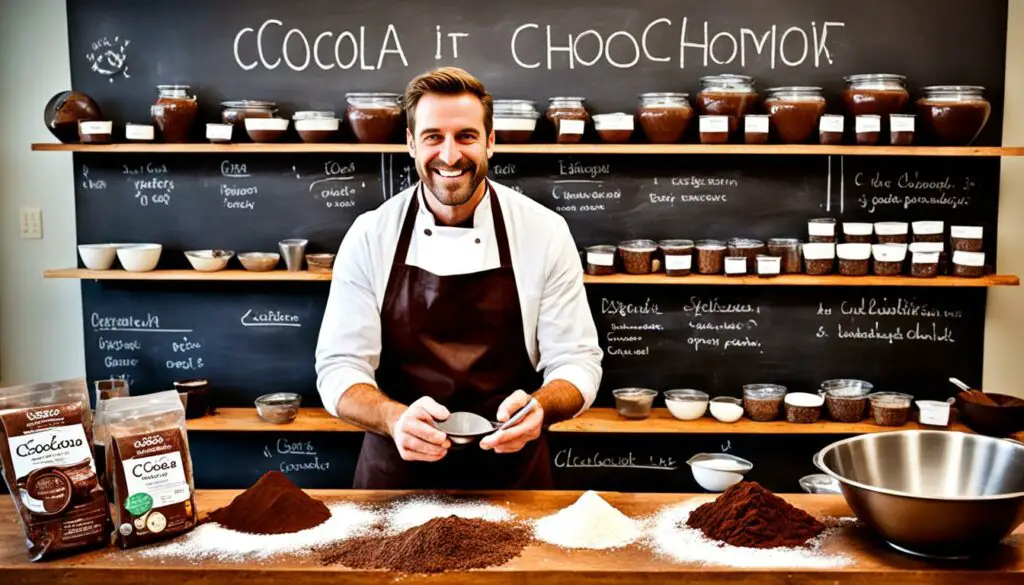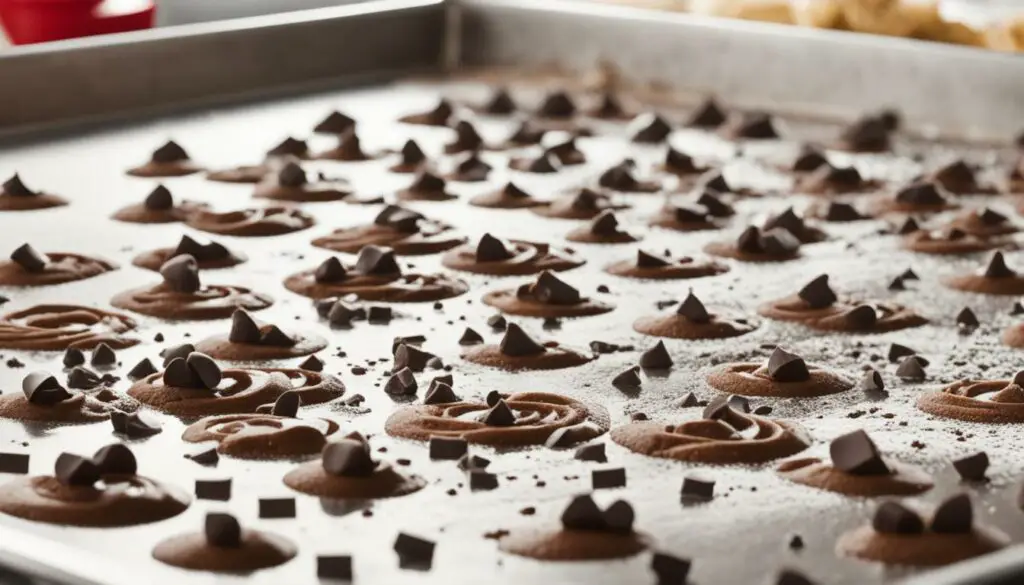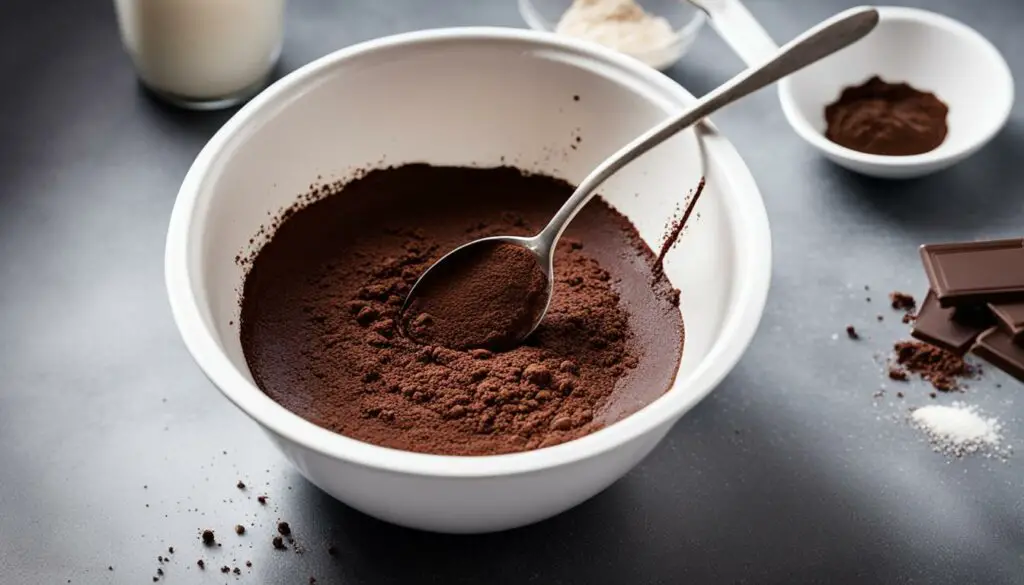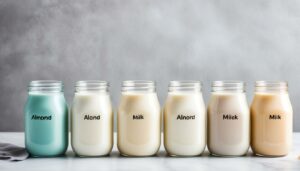Originally posted on February 10, 2024 @ 8:05 am
Have you ever found yourself in the middle of baking a delicious recipe, only to realize you’re missing a key ingredient – cocoa powder? Don’t worry, you’re not alone. Whether you’re out of cocoa powder or simply want to try a cocoa-free version of your favorite recipe, there are alternatives that can help you achieve the same delicious results. In this article, we’ll explore the possibilities of removing cocoa from a recipe and how to substitute it with other ingredients.
Contents
- 1 Can You Use Cocoa Powder Instead of Baking Chocolate?
- 2 How to Replace Cocoa Powder with Cooking Chocolate?
- 3 Can You Use Hot Chocolate Powder Instead of Cocoa Powder?
- 4 Can You Use Chocolate Chips Instead of Cocoa Powder?
- 5 Can You Use Dark Chocolate Instead of Cocoa Powder?
- 6 Does It Matter Which Cocoa Powder You Use?
- 7 How to Substitute Natural Cocoa for Dutch-Process Cocoa?
- 8 How to Substitute Dutch-Process Cocoa for Natural Cocoa?
- 9 When to Use Either Type of Cocoa?
- 10 The Single-Cocoa Solution: Triple Cocoa Blend
- 11 Conclusion
- 12 FAQ
- 12.1 Can you take cocoa out of a recipe?
- 12.2 Can you use cocoa powder instead of baking chocolate?
- 12.3 How to replace cocoa powder with cooking chocolate?
- 12.4 Can you use hot chocolate powder instead of cocoa powder?
- 12.5 Can you use chocolate chips instead of cocoa powder?
- 12.6 Can you use dark chocolate instead of cocoa powder?
- 12.7 Does it matter which cocoa powder you use?
- 12.8 How to substitute natural cocoa for Dutch-process cocoa?
- 12.9 How to substitute Dutch-process cocoa for natural cocoa?
- 12.10 When to use either type of cocoa?
- 12.11 What is the single-cocoa solution: Triple Cocoa Blend?
- 13 Source Links
Key Takeaways:
- Removing cocoa from a recipe is possible by using suitable substitutes.
- When substituting cocoa powder with other ingredients, adjustments may be needed to ensure the desired flavor and texture.
- Cocoa powder can be replaced with baking chocolate, hot chocolate powder, chocolate chips, or dark chocolate, depending on the recipe.
- The choice between natural cocoa and Dutch-process cocoa can impact the leavening process in your recipe.
- Experimentation and personal taste preferences are key to discovering new and delicious cocoa-free recipes.
Can You Use Cocoa Powder Instead of Baking Chocolate?

Yes, you can use cocoa powder instead of baking chocolate in a recipe. The most important thing to keep in mind is the adjustment you need to make in the other ingredients. As mentioned earlier, you should use three tablespoons of cocoa powder and one tablespoon of butter or vegetable oil for every 30 grams of baking chocolate. This substitution will give your recipe a different flavor profile, as cocoa powder has a more intense taste. However, it can still be a great alternative if you don’t have baking chocolate on hand.
When using cocoa powder as a replacement for baking chocolate, keep in mind that the intensity of the cocoa flavor may require adjustments to the sweetness of the recipe. You may need to add additional sugar if the original recipe calls for sweetened baking chocolate. Additionally, cocoa powder contains less fat compared to baking chocolate, so incorporating butter or vegetable oil is necessary to maintain the desired texture and moisture in the final baked goods.
To further demonstrate the conversion from baking chocolate to cocoa powder, refer to the following table:
Baking Chocolate (30g) Cocoa Powder (3 tbsp) Butter/Vegetable Oil (1 tbsp) Unsweetened ✓ ✓ Semisweet ✓ ✓ Sweetened ✓ ✗ Dark ✓ ✓ Milk ✓ ✓
This table provides a general guideline for converting baking chocolate to cocoa powder in various forms. It’s important to consider the specific requirements of your recipe and make adjustments accordingly. Remember, experimenting with different ratios and flavors can lead to delightful variations and unique creations.
How to Replace Cocoa Powder with Cooking Chocolate?

If you need to substitute cocoa powder with cooking chocolate in a recipe, there is a reliable conversion method you can follow. For every three tablespoons of cocoa powder called for in the recipe, you can use 30 grams of cooking chocolate and reduce the amount of butter or oil by 1 tablespoon. Cooking chocolate, also known as culinary chocolate or bitter chocolate, contains less sugar and a higher percentage of cocoa solids compared to regular chocolate. This makes it a suitable alternative for cocoa powder in certain recipes.
However, if the original recipe specifically calls for baking chocolate or cooking chocolate, using normal chocolate may result in a slightly different outcome. In such cases, it is important to adjust the other ingredients accordingly to maintain the desired texture and flavor.
So, how can you replace cocoa powder with cooking chocolate in your recipe? Here’s a conversion table to guide you:
| Cocoa Powder | Cooking Chocolate | Butter/Oil |
|---|---|---|
| 3 tablespoons | 30 grams | 1 tablespoon less |
Using this conversion table, you can confidently adapt your recipe to accommodate the use of cooking chocolate instead of cocoa powder. Remember to always read the recipe instructions carefully and make adjustments as needed to ensure a delicious outcome.
If you’re looking to add a visual element to your baking endeavors, here’s an enticing image to inspire your cocoa-free cooking adventures. It’s important to explore alternatives and experiment with different ingredients to achieve unique and delightful flavors in your recipes.
Can You Use Hot Chocolate Powder Instead of Cocoa Powder?

While hot chocolate powder may seem like a convenient substitute for cocoa powder, it’s not ideal for all baking purposes. Hot chocolate powder typically contains additional ingredients such as milk powder and sugar, which can affect the taste and texture of your baked goods. Substituting hot chocolate powder for cocoa powder may result in sweeter and less intense chocolate flavor in your desserts.
However, if you still want to use hot chocolate powder in your recipes, there are some adjustments you can make. You can try using twice as much hot chocolate powder as you would use cocoa powder to maintain a similar level of flavor. Additionally, you may need to reduce the amount of sugar in the recipe to account for the added sweetness from the hot chocolate powder.
Alternatively, if you’re looking for a cocoa-free option in your baking, you can consider using cooking chocolate as a substitute for cocoa powder. For every 24 grams (three tablespoons) of cocoa powder required, you can use 30 grams of cooking chocolate and reduce the amount of butter or oil by 15 grams. This substitution provides a closer flavor and texture match to cocoa powder in your recipes.
Comparison: Cocoa Powder vs. Hot Chocolate Powder
| Cocoa Powder | Hot Chocolate Powder |
|---|---|
| Intense chocolate flavor | Sweeter and less intense chocolate flavor |
| No added sugar | May contain added sugar |
| No added milk powder | May contain added milk powder |
| Versatile in baking and cooking | Best suited for making hot chocolate drinks |
It’s important to note that while hot chocolate powder can be used as a substitute in certain recipes, it may not provide the same depth of flavor and richness that cocoa powder offers. Consider your desired outcome and the specific requirements of your recipe when deciding whether to substitute hot chocolate powder for cocoa powder.
Remember, experimentation is key in the kitchen, and adjusting the ingredients to suit your taste preferences can lead to delicious and unique creations. Enjoy the process of exploring different substitutes and discovering new flavors in your cocoa-free baking adventures!
Can You Use Chocolate Chips Instead of Cocoa Powder?

While you can certainly experiment with using chocolate chips as a substitute for cocoa powder in certain recipes, there are a few factors to consider. Chocolate chips, typically used for adding texture and pockets of chocolate in baked goods, contain more sugar and have a lower percentage of cocoa solids compared to cocoa powder. This can affect the overall flavor and sweetness of your recipe.
To successfully use chocolate chips in place of cocoa powder, consider making the following adjustments:
- Reduce the amount of sugar in your recipe. Since chocolate chips already contain sugar, you may want to slightly decrease the amount of added sugar to prevent the final product from becoming overly sweet.
- Pre-melt the chocolate chips in a bain marie or using a microwave, and then let them cool slightly before incorporating them into the batter. This will help ensure that the chocolate chips distribute evenly throughout the recipe and melt properly during baking.
Alternatively, if you prefer a more controlled substitution, you can chop up a normal bar of chocolate and use it as a replacement for chocolate chips. This will provide a higher percentage of cocoa solids and allow for better flavor control.
Remember that using chocolate chips instead of cocoa powder may result in a slightly different texture and taste in your baked goods. Experimentation is key to finding the perfect balance and discovering delicious chocolate-free recipes.
| Ingredient | Cocoa Powder | Chocolate Chips |
|---|---|---|
| Sugar Content | Low or None | Higher (already sweetened) |
| Cocoa Solids Percentage | Varies, but can be up to 100% | Lower (around 35-60%) |
| Texture | No chunks, finely ground | Chewy, may not fully melt |
| Taste | Pure chocolate flavor | Slightly sweeter, less intense flavor |
Can You Use Dark Chocolate Instead of Cocoa Powder?

When it comes to cocoa-free baking and finding a suitable cocoa replacement in your recipes, dark chocolate can be a delicious option to consider. While the flavor of dark chocolate is similar to cocoa powder, it’s important to note that the proportions may vary when substituting one for the other.
If you want to use cocoa powder as a dark chocolate substitute, you can use the following proportions: 55 grams of cocoa powder and 45 grams of butter or another fat for every 100 grams of dark chocolate required. This substitution will give your recipe a rich chocolate flavor, although it may not result in an exact taste match.
When choosing dark chocolate, opt for unsweetened dark chocolate or raw cacao powder to reap the full health benefits. These options contain a higher percentage of cocoa solids and are lower in sugar content compared to other types of chocolate.
| Ingredient | Substitution |
|---|---|
| Dark Chocolate (100g) | 55g Cocoa Powder + 45g Butter or Fat |
Using dark chocolate as a substitute in cocoa-free baking can add depth and richness to your recipes. Whether you’re making decadent brownies, flavorful cakes, or silky-smooth sauces, experimenting with dark chocolate can result in delightful and indulgent creations.
Quote:
“Dark chocolate is not only delicious but also provides health benefits with its high cocoa content. Incorporating it into your baking is not just a substitution; it’s a winning choice!”
Does It Matter Which Cocoa Powder You Use?
When it comes to cocoa powder, the choice between natural cocoa and Dutch-process cocoa can have an impact on the leavening process in your recipe. Let’s take a closer look at the differences and how they can affect your cocoa-free baking and cooking.
Understanding the Acidity Levels
Natural cocoa: Natural cocoa is usually acidic in nature and is commonly used in recipes that call for baking soda as the leavening agent. The acidity of natural cocoa reacts with the baking soda to create carbon dioxide, which helps your baked goods rise.
Dutch-process cocoa: On the other hand, Dutch-process cocoa has been treated with an alkalizing agent to neutralize its acidity. This cocoa powder is often used in recipes that require baking powder as the leavening agent. The neutral pH of the Dutch-process cocoa allows the baking powder to provide the necessary rise for your baked goods.
In most cases, recipes will call for either unsweetened cocoa, Dutch-process, or natural cocoa, making them interchangeable in terms of flavor. The key difference lies in the leavening agents used and their reactions with the acidity levels of the cocoa powder.
Substituting Cocoa Powders
Should you find yourself needing to substitute one type of cocoa powder for the other, it’s essential to consider the acidity levels and adjust the leavening agents accordingly. Here’s a quick guide:
If your recipe calls for natural cocoa but you only have Dutch-process cocoa, you can make a 1-to-1 substitution. Be aware that your baked goods will be darker in color and you may notice a slight soapy flavor due to the baking soda. To minimize these changes, you can replace the baking soda with twice the amount of baking powder while keeping the other ingredients the same. This adjustment will help your baked goods rise properly without the assistance of the natural cocoa’s acidity.
If your recipe calls for Dutch-process cocoa but you only have natural cocoa on hand, you’ll need to adjust the leavening agents as well. Replace the baking powder in the recipe with half the amount of baking soda while keeping the other ingredients the same. This adjustment will ensure the proper rise of your baked goods without the neutralized acidity of the Dutch-process cocoa.
Comparing Natural Cocoa and Dutch-Process Cocoa
| Natural Cocoa | Dutch-Process Cocoa |
|---|---|
| Acidic | Alkalized |
| Used with baking soda | Used with baking powder |
| Produces a lighter color | Produces a darker color |
| Has a slightly tangy flavor | Has a milder, less tangy flavor |
As you can see, while there are differences between natural cocoa and Dutch-process cocoa, most recipes will allow for the interchangeable use of unsweetened cocoa powder. Understanding the role of leavening agents and the impact of acidity in your recipe will help you achieve the desired results when substituting cocoa powders.
How to Substitute Natural Cocoa for Dutch-Process Cocoa?
If your recipe calls for Dutch-process cocoa but you only have natural cocoa on hand, don’t worry! You can still make a successful substitution by making a few adjustments. Keep in mind that the color of your baked goods may be lighter, and there might be a subtle tanginess or slightly bitter edge to the flavor. However, with the right modifications, you can minimize these differences and still achieve delicious results.
If the recipe calls for 3 tablespoons of cocoa or less, there’s no need to make any adjustments. Simply use the same amount of natural cocoa as the recipe calls for Dutch-process cocoa. The difference in flavor and color will be minimal, and your baked goods will still turn out great.
However, if the recipe calls for more than 3 tablespoons of cocoa, you’ll need to tweak the leavening agents to compensate for the difference in acidity between Dutch-process and natural cocoa. Here’s what you should do:
- For every 1 tablespoon of baking powder called for in the recipe, reduce it to ½ tablespoon.
- Keep the other ingredients the same as mentioned in the original recipe.
By reducing the amount of baking powder, you’ll balance the acidity levels and achieve desirable results with natural cocoa. The slight adjustments ensure that your baked goods rise properly and maintain their texture despite the substitution.
Note: Natural cocoa is more acidic compared to Dutch-process cocoa. It’s typically used with baking soda as the leavening agent since the acidity activates the soda’s rising properties. Reducing the baking powder in the recipe helps maintain the proper balance between the leavening agents.
Now that you know how to replace Dutch-process cocoa with natural cocoa, go ahead and confidently explore a wider range of recipes using the cocoa you have on hand!
How to Substitute Dutch-Process Cocoa for Natural Cocoa?
If your recipe calls for natural cocoa but you only have Dutch-process cocoa, you can make a 1-to-1 substitution. Be aware that your baked goods will be darker in color and you may notice a slight soapy flavor due to the baking soda. To minimize these changes, you can replace the baking soda with twice the amount of baking powder while keeping the other ingredients the same. This adjustment will help your baked goods rise properly without the assistance of the natural cocoa’s acidity.
| Natural Cocoa | Dutch-Process Cocoa | Baking Soda | Baking Powder |
|---|---|---|---|
| 1 cup | 1 cup | 1/2 tsp | 1 tsp |
| 1/2 cup | 1/2 cup | 1/4 tsp | 1/2 tsp |
| 1/4 cup | 1/4 cup | 1/8 tsp | 1/4 tsp |
Note: The table above shows the conversion of natural cocoa and Dutch-process cocoa with their respective baking soda and baking powder measurements for ease of substitution.
When to Use Either Type of Cocoa?
In recipes that don’t rely heavily on leavening agents such as baking soda or baking powder, you have the flexibility to choose either natural cocoa or Dutch-process cocoa based on your personal preference. This opens up a world of possibilities for cocoa replacements in various recipes. Some examples of recipes where you can freely interchange cocoa types include hot cocoa, fudge frosting, and certain cookies or cakes where the cocoa is primarily used for flavor and color rather than leavening.
Natural cocoa offers a mild, light flavor that works well in recipes that call for a more subtle chocolate taste. It imparts a pleasant, delicate chocolate essence to the dish. On the other hand, Dutch-process cocoa provides a darker and more bittersweet experience. With its rich and intense flavor, it adds a deep chocolatey profile to your baked goods or desserts.
When deciding between the two, consider the desired taste and color you want to achieve in your recipe. If you prefer a milder chocolate flavor or a lighter-hued finished product, natural cocoa is an excellent choice. On the contrary, if you crave a bold and robust chocolate taste or a darker appearance in your creations, Dutch-process cocoa is the way to go.
Ultimately, the decision of when to use either type of cocoa comes down to personal preference and the specific requirements of your recipes. Whichever cocoa variety you choose, rest assured that there are delicious alternatives available to create cocoa-free or cocoa-reduced versions of your favorite treats.
The Single-Cocoa Solution: Triple Cocoa Blend
If you prefer a single-cocoa option in your pantry, a triple cocoa blend is the answer. This blend combines both natural and Dutch-process cocoa, allowing you to use it interchangeably in recipes that call for either type of cocoa. With a balanced mix of flavors, you never have to worry about having the wrong cocoa on hand. This is a convenient option for those who don’t have the space or desire to stock multiple varieties of cocoa.
If you’re looking for a versatile cocoa replacement in recipes, alternatives to cocoa, or a cocoa-free option, the triple cocoa blend is a great choice. It provides the flexibility and convenience of having just one type of cocoa powder while still offering the distinct flavors of both natural and Dutch-process cocoa.
Benefits of the Triple Cocoa Blend:
- Convenient single-cocoa option
- Combines the flavors of natural and Dutch-process cocoa
- Interchangeable in recipes calling for either type of cocoa
- No need to stock multiple varieties of cocoa
- Provides a balanced mix of flavors
“The triple cocoa blend is a game-changer in the kitchen. It simplifies my baking process by offering a single cocoa option that works well in any recipe. Plus, I love the balanced flavors it brings to my desserts!” – Sarah, home baker
Whether you’re making chocolate cake, brownies, or hot chocolate, the triple cocoa blend ensures consistent results and a rich chocolate flavor. Keep this versatile blend in your pantry for quick and easy cocoa substitution in any recipe.
Next, let’s take a look at some of the other cocoa substitutes you can use in your recipes.
Conclusion
In conclusion, cocoa powder is a versatile ingredient that can be used as a cocoa-free substitute in various recipes. By making necessary adjustments to the other ingredients, you can achieve a similar flavor profile and texture in your dishes. Whether you are replacing cocoa powder with baking chocolate or vice versa, it is essential to consider the differences in flavor, fat content, and sugar levels.
Understanding the role of leavening agents and the acidity of cocoa is also crucial in achieving the desired outcome in your baked goods. By experimenting with different ratios and taking personal taste preferences into account, you can discover new and delicious cocoa-free recipes that satisfy your cravings for chocolate-rich treats.
So, the next time you find yourself without cocoa powder or baking chocolate, don’t worry! With a little creativity and the right adjustments, you can still enjoy cocoa-free baking and cooking. Explore the possibilities, try out new combinations, and delight in the delightful flavors created with cocoa substitutes. Happy baking!
FAQ
Can you take cocoa out of a recipe?
Yes, you can remove cocoa from a recipe and make adjustments to the other ingredients for a cocoa-free version.
Can you use cocoa powder instead of baking chocolate?
Yes, you can substitute cocoa powder for baking chocolate by making adjustments to the other ingredients.
How to replace cocoa powder with cooking chocolate?
To replace cocoa powder with cooking chocolate, you can adjust the amount of cooking chocolate and fats used in the recipe.
Can you use hot chocolate powder instead of cocoa powder?
While not ideal, you can use hot chocolate powder as a substitute for cocoa powder by making adjustments to the recipe.
Can you use chocolate chips instead of cocoa powder?
Yes, you can use chocolate chips as a substitute for cocoa powder by adjusting the recipe and pre-melting the chocolate chips.
Can you use dark chocolate instead of cocoa powder?
Yes, you can use dark chocolate as a substitute for cocoa powder, but adjustments may be needed to achieve the desired flavor.
Does it matter which cocoa powder you use?
The choice between natural cocoa and Dutch-process cocoa can affect the leavening process in your recipe.
How to substitute natural cocoa for Dutch-process cocoa?
To substitute natural cocoa for Dutch-process cocoa, you can adjust the leavening agents in the recipe.
How to substitute Dutch-process cocoa for natural cocoa?
To substitute Dutch-process cocoa for natural cocoa, you can adjust the leavening agents in the recipe.
When to use either type of cocoa?
You can use either natural cocoa or Dutch-process cocoa based on your personal taste and the desired outcome of the recipe.
What is the single-cocoa solution: Triple Cocoa Blend?
The triple cocoa blend combines both natural and Dutch-process cocoa, offering a balanced mix for versatile use in recipes.








